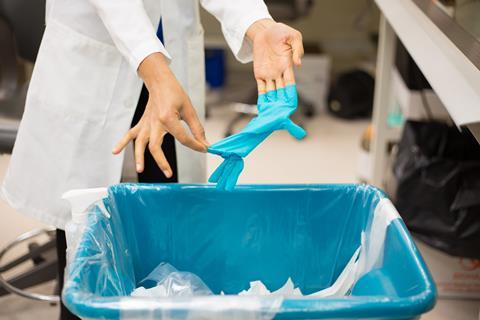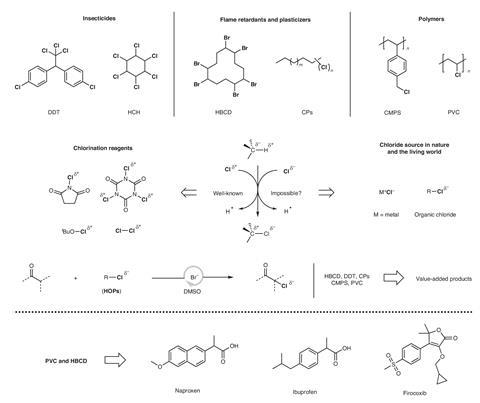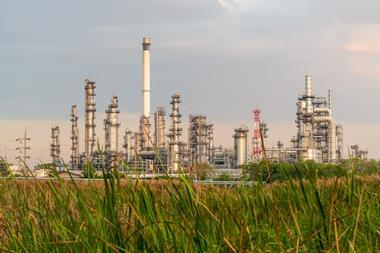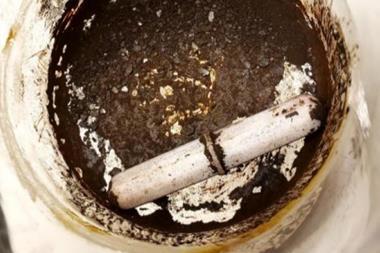Persistent halogenated pollutants can be repurposed to act as effective chlorinating agents, simultaneously reducing their impact on the environment. The team in China used environmental contaminants including the banned insecticide DDT and flame-retardant insulator hexabromocyclododecane (HBCD) to chlorinate a variety of ketone and alkene substrates, ultimately incorporating a pollutant-mediated step into the syntheses of several non-steroidal anti-inflammatory drugs.

Organic halides are a versatile class of compounds. The polar C–X bond is a convenient functional handle in synthetic organic chemistry but also confers a number of useful properties including flame retardance, lipophilicity and chemical resistance, making these compounds excellent for diverse applications such as building materials, plastics and pesticides. However, while the strength of this bond makes these materials physically tough and resistant to chemical degradation, it has also led to the problem of persistent halogenated compounds in the environment. In particular, their lipophilicity has had a devastating cumulative impact on food chains and strategies to safely process and dispose of these substances are now an important part of environmental policy.
Currently, stockpiles of halogenated organic pollutants are decomposed to destroy them and prevent them from entering the environment but, given the expense of introducing halogen atoms into compounds during synthesis, alternative methods which recover or reuse this valuable functionality are in demand. Unfortunately, organohalides’ chemistry has made recycling difficult to achieve thus far, explains Graham Pattison, an organohalide chemist at the University of Lincoln, UK. ‘The chlorinating agents we use in the lab like N-chlorosuccinimide deliver the chloride electrophilically, ie as Cl+,’ he says. ‘But these pollutants decompose into chloride anions, Cl-, which are a nucleophilic source of chlorine and less easy to react.’
This reactivity problem has now been solved by Qing-An Chen and colleagues at the Chinese Academy of Sciences who used an alkyl bromide catalyst in dimethyl sulfoxide (DMSO) to facilitate the transfer of chloride anions to a variety of ketone and alkene substrates. The team’s simple approach capitalises on the reactivity differences between halide species and cleverly employs the solvent to promote individual substitution and elimination steps in the mechanism, according to Pattison.
In the first step, the alkyl bromide catalyst decomposes into a bromide anion, assisted by the polar solvent. The DMSO then oxidises this nucleophilic anion to an electrophilic bromide cation which can react electrophilically with the ketone or alkene substrate. In parallel, the same DMSO-promoted decomposition process converts the chlorine-containing pollutant into Cl- ions, ready to act as a nucleophilic source of chlorine. ‘The chloride anion is harder to oxidise than Br- so the DMSO can’t oxidise Cl- to Cl+. That’s why they need the bromide catalyst,’ explains Pattison. ‘But the chloride makes a stronger bond with carbon so it can substitute into the brominated intermediate to form the chlorinated product.’

With these conditions validated, the team trialled the reaction with a number of commercial halogenated organic pollutants including the flame-retardant HBCD, chlorinated paraffins used as plasticisers and the common plastic polyvinyl chloride, in each case achieving good yields of the chlorinated product. The reaction even translated effectively to real-world environmental wastes. When used as the chlorine source, soil samples contaminated with the potent insecticide DDT gave the expected chlorination product in 49% yield while simultaneously reducing the toxicity of the agricultural material.
In a final proof-of-concept demonstration, Chen’s team incorporated a HBCD-mediated chlorination step into the synthesis of three common non-steroidal anti-inflammatory drugs highlighting the potential application of this method in pharmaceutical synthesis.

‘It’s a really simple and attractive approach which allows us to generate chlorinated products quite easily from waste products,’ says Pattison. ‘The next steps will be to show that this works on more drug-like substrates and to get the scale up to make it industrially relevant. It would also be nice if they could demonstrate it on other kinds of reaction like aromatic or radical chlorination which are widely used in drug synthesis.’
References
H Liu et al, Nat. Chem., 2024, DOI: 10.1038/s41557-024-01551-8

















1 Reader's comment